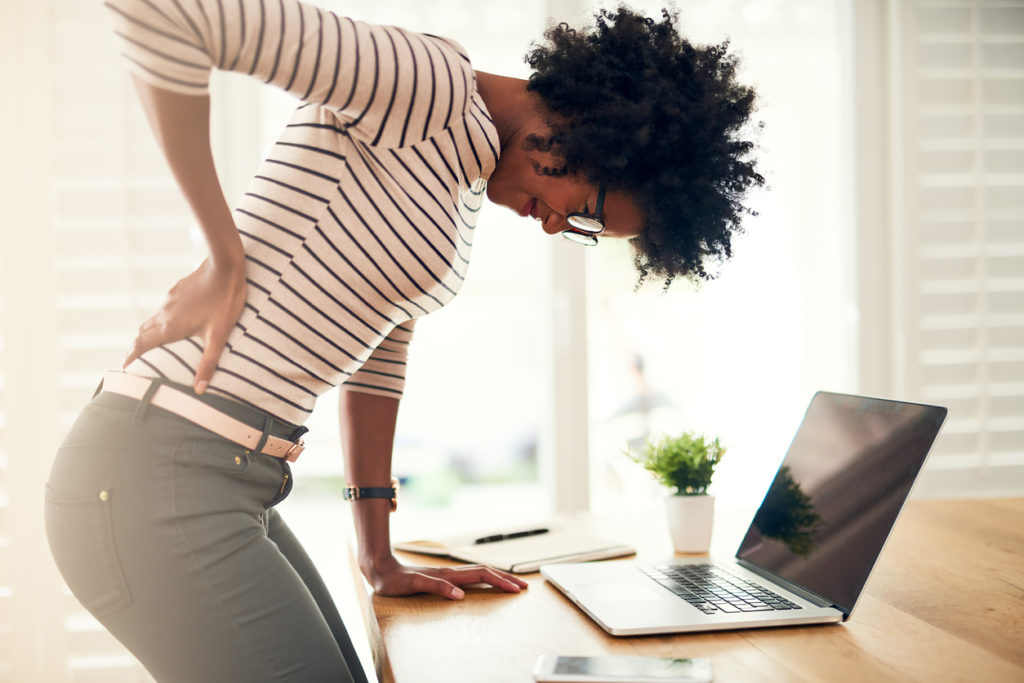5 MAJOR CAUSES LOWER BACK PAIN

What causes lower back Pain?
Contents
What are the primary causes of lower back pain?
Low back pain caused by spinal degeneration and injury.
Muscle or ligament strain. Repeated heavy lifting or a sudden awkward movement can strain back muscles and spinal ligaments. …
Bulging or ruptured disks. Disks act as cushions between the bones (vertebrae) in your spine. …
Arthritis. …
Osteoporosis.
Lower back pains can be extremely painful and be a constant spoilsport of everyday work and play. Best case scenario, they become chronic. In worst case scenario, it turns out to be some serious tissue or bone injury that would require medication or even surgery.
https://bestipsdaily.com/arthritis-and-exercise-guidelines/
Also Read : 4 Effective Ways of Treating Back Pain
The reasons why a person has lower back pain may vary from person to person. But here some of the most common causes of it:
Osteoarthritis
Arthritis is an umbrella term for a lot of pains, inflammations, and stiffness that occur in our bodies. Osteoarthritis means it has happened in the bones. Rubbing of bones at the joints in the lower spine or pelvic girdle can cause a tremendous amount of pain. Excessive friction can dry up the juice between the facet joints and also cause bone spurs. There is no such lower back pain treatment for osteoarthritis. You just have to exercise, stay fit and put as less pressure on the lower back as possible.
Muscle cramps and spasms
Spasms can happen for a lot of reasons – a previous injury, excessive stress, a repercussion of some other bodily disorder. They can get really bad when the spasm attacks come. However, if it is something that can be fixed with exercise and therapy, you should go for it. Surgeries are not always the best treatment for lower back pain.
Disk degeneration
There is small disks present within each of our vertebrae to cushion the bone and also to prevent them from rubbing against each other. When these disks get damaged or somehow slip out from between the segment, it hurts the nerves of the lower back and causes pain to shoot down the legs as well.
Obesity
Obesity does not sound like something that would specifically harm your lower back, but it does. Excessive weight in the torso region puts immense pressure on down the waist. Also, obesity makes the muscles around your lower back lose, and they fail to provide support to your lumbar spine. Not only lower back, but overweight can also harm your pelvic bones and kneecaps as well.
Wrong body posture
Most works require sitting long hours at the desk. Any fit person would also get back pain from that. We often sit and work or walk in hunched, tilted or other postures that really put pressure on the lower back region and make the muscles there stiff.
Remember to keep your posture right and treat your back pain before it gets worse.
Prevention of lower back pain
You might avoid back pain or prevent its recurrence by improving your physical condition and learning and practicing proper body mechanics.
To keep your back healthy and strong:
- Exercise. Regular low-impact aerobic activities — those that don’t strain or jolt your back — can increase strength and endurance in your back and allow your muscles to function better. Walking and swimming are good choices. Talk with your doctor about which activities you might try.
- Build muscle strength and flexibility. Abdominal and back muscle exercises, which strengthen your core, help condition these muscles so that they work together like a natural corset for your back.
- Maintain a healthy weight. Being overweight strains back muscles. If you’re overweight, trimming down can prevent back pain.
- Quit smoking. Smoking increases your risk of low back pain. The risk increases with the number of cigarettes smoked per day, so quitting should help reduce this risk.
Avoid movements that twist or strain your back. Use your body properly:
- Stand smart. Don’t slouch. Maintain a neutral pelvic position. If you must stand for long periods, place one foot on a low footstool to take some of the load off your lower back. Alternate feet. Good posture can reduce the stress on back muscles.
- Sit smart. Choose a seat with good lower back support, armrests and a swivel base. Placing a pillow or rolled towel in the small of your back can maintain its normal curve. Keep your knees and hips level. Change your position frequently, at least every half-hour.
- Lift smart. Avoid heavy lifting, if possible, but if you must lift something heavy, let your legs do the work. Keep your back straight — no twisting — and bend only at the knees. Hold the load close to your body. Find a lifting partner if the object is heavy or awkward.
https://bestipsdaily.com/8-reasons-why-you-are-not-losing-weight/
https://bestipsdaily.com/8-reasons-why-you-are-not-losing-weight/
REFERENCES
- Back pain: In depth. National Institute of Arthritis and Musculoskeletal and Skin Diseases. https://www.niams.nih.gov/health-topics/back-pain/advanced. Accessed June 22, 2020.
- Low back pain: Fact sheet. National Institute of Neurological Disorders and Stroke. https://www.ninds.nih.gov/Disorders/Patient-Caregiver-Education/Fact-Sheets/Low-Back-Pain-Fact-Sheet. Accessed June 22, 2020.
- Chou R, et al. Nonpharmacologic therapies for low back pain: A systematic review for an American College of Physicians clinical practice guideline. Annals of Internal Medicine. 2017; doi:10.7326/M16-2459.
- Kellerman RD, et al. Spine pain. In: Conn’s Current Therapy 2020. Elsevier; 2020. https://www.clinicalkey.com. Accessed June 22, 2020.
- Low back pain. American Association of Neurological Surgeons. https://www.aans.org/en/Patients/Neurosurgical-Conditions-and-Treatments/Low-Back-Pain. Accessed June 22, 2020.


